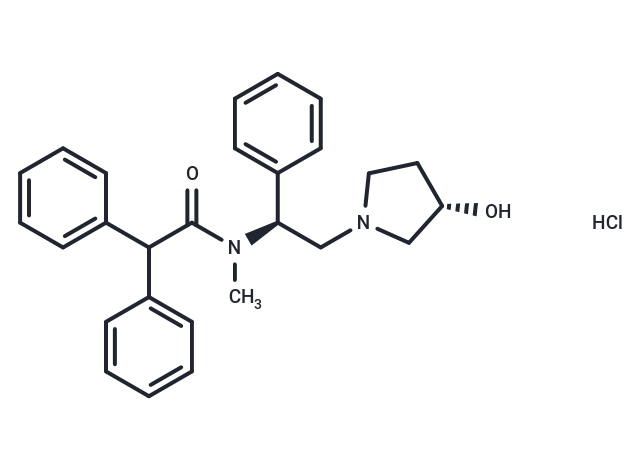Shopping Cart
Remove All Your shopping cart is currently empty
Your shopping cart is currently empty
Asimadoline hydrochloride (EMD-61753 hydrochloride) is a κ-opioid receptor agonist potentially for the treatment of pruritus. Asimadoline hydrochloride has also been shown to be used in the treatment of irritable bowel syndrome.

| Pack Size | Price | USA Warehouse | Global Warehouse | Quantity |
|---|---|---|---|---|
| 1 mg | $30 | In Stock | In Stock | |
| 5 mg | $67 | In Stock | In Stock | |
| 10 mg | $113 | In Stock | In Stock | |
| 25 mg | $239 | In Stock | In Stock | |
| 50 mg | $355 | In Stock | In Stock | |
| 100 mg | $526 | In Stock | In Stock | |
| 500 mg | $1,130 | - | In Stock | |
| 1 mL x 10 mM (in DMSO) | $74 | In Stock | In Stock |
| Description | Asimadoline hydrochloride (EMD-61753 hydrochloride) is a κ-opioid receptor agonist potentially for the treatment of pruritus. Asimadoline hydrochloride has also been shown to be used in the treatment of irritable bowel syndrome. |
| Targets&IC50 | κ opioid (human recombinant):1.2 nM (EC50), κ opioid (Guinea pig):5.6 nM (EC50) |
| In vitro | The IC50 for Asimadoline binding to μ-opioid receptors is 3 μM and to δ-opioid receptors is 0.7 μM. At high concentrations, Asimadoline demonstrates spasmolytic action against 400 μM barium chloride in the rat duodenum (IC50: 4.2 μM), suggesting that Asimadoline may block the direct stimulant effects of barium on smooth muscle through mechanisms that are not identified[1]. |
| In vivo | The metabolism of Asimadoline is rapid and appears similar in animals and man. The absorption rate following oral administration is 80% in rats and >90% in dogs and monkeys. Asimadoline has peripheral anti-inflammatory actions that are partly mediated through an increase in joint fluid substance P levels[1]. Treatment with Asimadoline (5 mg/kg/day i.p.) produces marked (and sustained) attenuation of the disease with all three-time regimes[2]. |
| Animal Research | Asimadoline (5 mg/kg/day, n=10 per group) or vehicle (2 mL/kg/day, n=10) is administered to DA rats by i.p. injection twice daily (i) during the primary inflammatory phase (days 1–3); (ii) once the disease is established (days 13–21); or (iii) throughout the entire time course (days 1-21). Non-arthritic control animals receive Asimadoline (5 mg/kg/day, n=5) or vehicle (2 mL/kg/day, n=5) by i.p. injection twice daily. In all cases, disease parameters are assessed. In this experiment, the SP content of joint tissue is assessed only after the rats are killed (day 21)[2]. |
| Synonyms | EMD-61753 hydrochloride |
| Molecular Weight | 451.01 |
| Formula | C27H31ClN2O2 |
| Cas No. | 185951-07-9 |
| Smiles | C(C(N([C@H](CN1CC[C@H](O)C1)C2=CC=CC=C2)C)=O)(C3=CC=CC=C3)C4=CC=CC=C4.Cl |
| Relative Density. | no data available |
| Storage | Powder: -20°C for 3 years | In solvent: -80°C for 1 year | Shipping with blue ice/Shipping at ambient temperature. | |||||||||||||||||||||||||||||||||||
| Solubility Information | DMSO: 60 mg/mL (133.03 mM), Heating is recommended. | |||||||||||||||||||||||||||||||||||
| In Vivo Formulation | 10% DMSO+40% PEG300+5% Tween 80+45% Saline: 5 mg/mL (11.09 mM), Sonication is recommended. Please add the solvents sequentially, clarifying the solution as much as possible before adding the next one. Dissolve by heating and/or sonication if necessary. Working solution is recommended to be prepared and used immediately. The formulation provided above is for reference purposes only. In vivo formulations may vary and should be modified based on specific experimental conditions. | |||||||||||||||||||||||||||||||||||
Solution Preparation Table | ||||||||||||||||||||||||||||||||||||
DMSO
| ||||||||||||||||||||||||||||||||||||
| Size | Quantity | Unit Price | Amount | Operation |
|---|

Copyright © 2015-2025 TargetMol Chemicals Inc. All Rights Reserved.